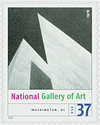
# 3910g - 2005 37c Modern American Architecture: National Gallery of Art
37¢ National Gallery of Art
Modern American Architecture
City: Las Vegas, NV
Printing Method: Lithographed
Color: Multicolored
National Gallery Of Art Opens
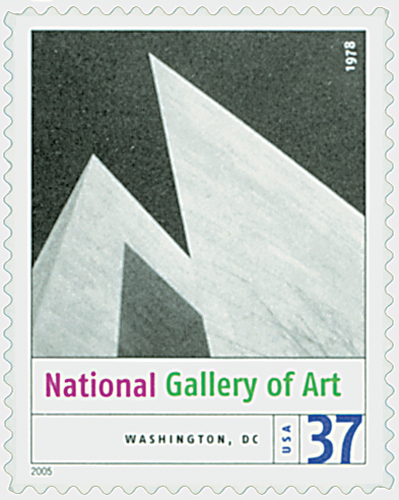
On March 17, 1941, President Franklin Roosevelt presided over the opening of the National Gallery of Art.
Andrew Mellon made his fortune in oil, steel, shipbuilding, and construction, becoming one of the wealthiest people in America. During World War I, Mellon used his wealth to build a private art collection of old master paintings and sculptures. Appointed Secretary of the Treasury in 1921, he moved to Washington, D.C., and soon realized that America should have a national art museum like the ones in other great nations.

After years of adding to his collection and planning, Mellon wrote to President Franklin D. Roosevelt in 1936 to formally offer his collection and the funds necessary to build the gallery. President Roosevelt supported his idea and promoted it to Congress. On Mellon’s birthday, March 24, 1937, Congress accepted his proposal, officially establishing the gallery.
Mellon selected architect John Russell Pope to design the museum on the site of the former Baltimore and Potomac Railroad station in Washington, D.C. (Interestingly, this was the spot where Charles Guiteau shot President James Garfield in 1881). Mellon insisted that the gallery not bear his name, to encourage others to donate their art collections. And several did, both before it was completed and in the years since. Unfortunately, neither Mellon nor Pope would live to see the completed gallery, as both men died within a day of each other in August 1937, just two months after excavation began.
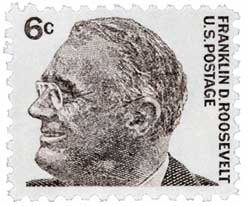
Once construction was completed in December 1940, the National Gallery of Art was the largest marble structure in the world at the time. Three months later, on March 17, 1941, the gallery officially opened to the public, with over 8,000 people in attendance. Andrew Mellon’s son, Paul Mellon, presented the museum to the nation on his father’s behalf, with President Roosevelt accepting it.
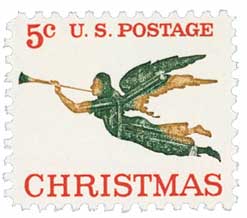
In his speech, President Roosevelt said, “though there have been many public gifts of art in the past, the gift of this National Gallery, dedicated to the entire Nation, containing a considerable part of the most important work brought to this country from the continent of Europe, has necessarily a new significance. I think it signifies a relation – a new relation here made visible in paint and in stone – between the whole people of this country, and the old inherited tradition of the arts. And we shall remember that these halls of beauty, the conception of a great American architect, John Russell Pope, combine the classicism of the past with the convenience of today.” Click here to read the full text of President Roosevelt’s speech. Or listen to it here.
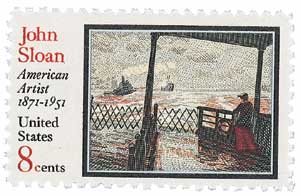
When Mellon first planned the gallery, he knew it would one day outgrow its home. With this in mind, he requested that Congress set aside a nearby plot of land for future development. As he foresaw, the gallery reached its capacity in the 1960s. His children then offered the funds for the construction of a second building and hired architect I.M. Pei to design it. Construction began in 1971 was but progressed slowly due to the complexity of the design. After it was completed, President Jimmy Carter dedicated the new gallery on June 1, 1978. In 1999, the gallery opened its third section, the Art Sculpture Garden.
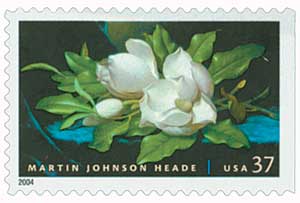
Today, the gallery houses almost 4,000 paintings, 3,000 sculptures, 70,000 prints, 31,000 drawings, and 15,000 photographs, in addition to decorative arts. It’s also the only museum in America to house a painting by Leonardo da Vinci.
Several U.S. Christmas stamps feature art that hangs in the National Gallery. You can view them here.
37¢ National Gallery of Art
Modern American Architecture
City: Las Vegas, NV
Printing Method: Lithographed
Color: Multicolored
National Gallery Of Art Opens

On March 17, 1941, President Franklin Roosevelt presided over the opening of the National Gallery of Art.
Andrew Mellon made his fortune in oil, steel, shipbuilding, and construction, becoming one of the wealthiest people in America. During World War I, Mellon used his wealth to build a private art collection of old master paintings and sculptures. Appointed Secretary of the Treasury in 1921, he moved to Washington, D.C., and soon realized that America should have a national art museum like the ones in other great nations.

After years of adding to his collection and planning, Mellon wrote to President Franklin D. Roosevelt in 1936 to formally offer his collection and the funds necessary to build the gallery. President Roosevelt supported his idea and promoted it to Congress. On Mellon’s birthday, March 24, 1937, Congress accepted his proposal, officially establishing the gallery.
Mellon selected architect John Russell Pope to design the museum on the site of the former Baltimore and Potomac Railroad station in Washington, D.C. (Interestingly, this was the spot where Charles Guiteau shot President James Garfield in 1881). Mellon insisted that the gallery not bear his name, to encourage others to donate their art collections. And several did, both before it was completed and in the years since. Unfortunately, neither Mellon nor Pope would live to see the completed gallery, as both men died within a day of each other in August 1937, just two months after excavation began.

Once construction was completed in December 1940, the National Gallery of Art was the largest marble structure in the world at the time. Three months later, on March 17, 1941, the gallery officially opened to the public, with over 8,000 people in attendance. Andrew Mellon’s son, Paul Mellon, presented the museum to the nation on his father’s behalf, with President Roosevelt accepting it.

In his speech, President Roosevelt said, “though there have been many public gifts of art in the past, the gift of this National Gallery, dedicated to the entire Nation, containing a considerable part of the most important work brought to this country from the continent of Europe, has necessarily a new significance. I think it signifies a relation – a new relation here made visible in paint and in stone – between the whole people of this country, and the old inherited tradition of the arts. And we shall remember that these halls of beauty, the conception of a great American architect, John Russell Pope, combine the classicism of the past with the convenience of today.” Click here to read the full text of President Roosevelt’s speech. Or listen to it here.

When Mellon first planned the gallery, he knew it would one day outgrow its home. With this in mind, he requested that Congress set aside a nearby plot of land for future development. As he foresaw, the gallery reached its capacity in the 1960s. His children then offered the funds for the construction of a second building and hired architect I.M. Pei to design it. Construction began in 1971 was but progressed slowly due to the complexity of the design. After it was completed, President Jimmy Carter dedicated the new gallery on June 1, 1978. In 1999, the gallery opened its third section, the Art Sculpture Garden.

Today, the gallery houses almost 4,000 paintings, 3,000 sculptures, 70,000 prints, 31,000 drawings, and 15,000 photographs, in addition to decorative arts. It’s also the only museum in America to house a painting by Leonardo da Vinci.
Several U.S. Christmas stamps feature art that hangs in the National Gallery. You can view them here.





